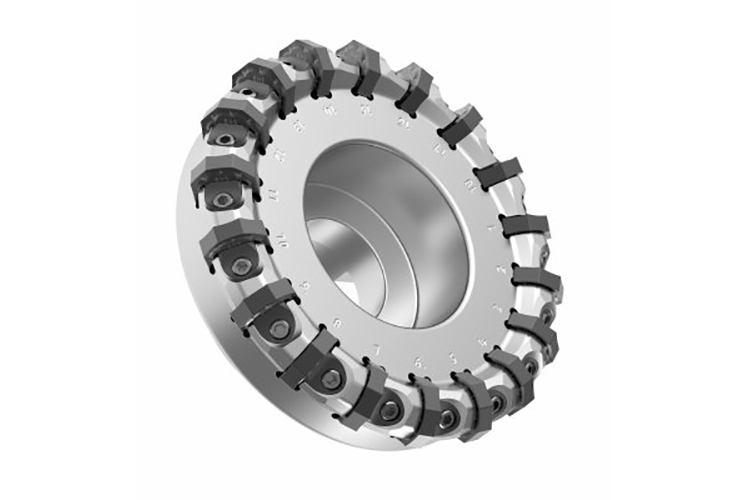Kennametal’s Mill 16 has a wedge-style clamping system, numbered pockets and inserts, and an open pocket design to increase chip flow in heavy roughing Iron is the most abundant element on earth by mass. For over twenty-five centuries it’s been used to plow fields, build bridges, cook food, and wage war. Without iron, the Industrial Revolution would have gone nowhere, we would have no trains, automobiles, or machine tools today, and mankind would still be an agrarian society. It is quite simply the most important metal in history
There’s a newcomer to this metal family, though, one that’s making manufacturers take notice. As automakers strive for increasingly fuel efficient and environmentally friendly vehicles, they’re turning away from traditional iron favorites such as gray and ductile iron (GCI and DCI) to compacted graphite iron, or CGI. Also known as vermiculate graphite iron, CGI’s mechanical attributes meet or exceed its counterparts, sometimes drastically so.

Unfortunately, CGI is also more difficult to machine, requiring cutting tools both tough and wear-resistant. And because of the continuing call for cost-effective machining solutions across all manufacturing industries, these tools must also offer a low cost per part and predictable tool life. For face milling applications, that tool is Mill 16™ “Compared to cast iron, CGI has lower weight and greater strength, and is ideal for components that are exposed to both thermal and mechanical stresses like engine blocks
and heads for cars and trucks, exhaust manifolds, and brake parts,” says Senior Global Product Manager for Indexable Milling, Marcelo Campos. “As with other cast irons, however, it is quite abrasive, and somewhat gummy to machine. We developed Mill 16 as a best in class face mill not only for CGI, but for all types of cast iron, which remains a popular choice for gear boxes, housings, pump bodies, and other components used in the automotive, agricultural, and heavy equipment sectors.”
Campos outlines Mill 16’s unique strengths as follows:
– The Mill 16 has a fine-pitch and medium pitch cutter body equipped with an innovative single-screw, wedge-style clamping system. This reduces time spent in the tool crib setting the tool and assures rigid, no-fail tool placement. Each pocket on the cutter body is numbered, as are each of the insert’s cutting edges, assuring maximum accuracy and ease of use when indexing to a new cutting edge.
– The heart of the Mill 16 is an octagonal, double-sided insert with 16 effective cutting edges, providing the lowest tooling cost per part possible. The face of each cutting edge contains an aggressive chip-breaker for positive cutting action and increased chip flow. The wedge clamp on either side of the insert’s top face is likewise chamfered to improve chip evacuation.

The finish machining operation on these ductile iron plates saw double the tool life and double the feed rate with Mill 16
– Mill 16 is available in cutter diameters ranging from 2 in. to 10 in. (50 mm to 250 mm). Kennametal has rated the maximum axial depth of cut (Ap1) at 5.5 mm (0.216 in.), although depths to 9 mm (0.35 in.) or greater are achievable, an important consideration where casting variation is a concern. Due to the cutter’s low cutting forces, up to 100% radial cutter engagement is possible. All cutters have internal coolant supply capability.
– The carbide is new as well. Kennametal’s grade KCK20 is a PVD AlTiN/AlTiCrN multilayer coating bonded to a wear resistant substrate which provides an average tool life of 30% greater than comparable TiAlN-coated grades.
– A wide assortment of insert edge preps, geometries, corner radii, as well as a number of complementary grades assure the Mill 16 is a top performer in a variety of machining conditions, from heavy roughing to semi-finishing and, because of the insert’s integrated wiper facet, fine finishing to Ra 3.2 μm or better.
Customer field tests have shown consistent and positive results. During a dry machining operation on a ductile cast iron plate using Mill 16, feed rates were increased by 41% and tool life doubled tool. A gray iron transmission case was machined at a feed rate of 0.39 mm per tooth (0.015 in.) and cutting speed of 208 m/min (682 ft/min), leading to reduced spindle loads compared to the legacy tool and slightly improved tool life. Metal removal rate and tool life on a water pump housing was more than doubled by switching to Mill 16. There are more examples. Campos says he’s worked extensively with automakers and their suppliers, and in all cases the Mill 16 outperformed his competitor’s cutting tools.
“We have cutting force dynamometers. We take videos. We run head to head tool life tests. For us to stand up and say we get 20% better tool life or 50% more metal removal than our next competitor, you can be certain it’s true. We at Kennametal are very excited about the Mill 16, and what it can do for our customers machining CGI and other types of cast iron.”


